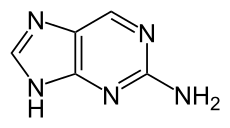2-Aminopurine
 | |
| Names | |
|---|---|
| IUPAC name
9H-purin-2-amine | |
| Identifiers | |
| 3D model (JSmol) |
|
| ChEBI | |
| ChemSpider | |
| ECHA InfoCard | 100.006.545 |
| PubChem CID |
|
| |
| |
| Properties | |
| C5H5N5 | |
| Molar mass | 135.13 g·mol−1 |
| Except where otherwise noted, data are given for materials in their standard state (at 25 °C [77 °F], 100 kPa). | |
| | |
| Infobox references | |
2-Aminopurine, an analog of guanine and adenine, is a fluorescent molecular marker used in nucleic acid research.[1] It most commonly pairs with thymine as an adenine-analogue, but can also pair with cytosine as a guanine-analogue;.[2] For this reason it is sometimes used in the laboratory for mutagenesis.
See also
References
- ↑ Jean JM, Hall KB (2001). "2-Aminopurine fluorescence quenching and lifetimes: role of base stacking". Proc. Natl. Acad. Sci. U.S.A. 98 (1): 37–41. PMC 14540
 . PMID 11120885. doi:10.1073/pnas.011442198.
. PMID 11120885. doi:10.1073/pnas.011442198. - ↑ Sowers LC, Fazakerley GV, Eritja R, Kaplan BE, Goodman MF (1986). "Base pairing and mutagenesis: observation of a protonated base pair between 2-aminopurine and cytosine in an oligonucleotide by proton NMR". Proc. Natl. Acad. Sci. U.S.A. 83 (15): 5434–5438. PMC 386301
 . PMID 3461441. doi:10.1073/pnas.83.15.5434.
. PMID 3461441. doi:10.1073/pnas.83.15.5434.
This article is issued from
Wikipedia.
The text is licensed under Creative Commons - Attribution - Sharealike.
Additional terms may apply for the media files.